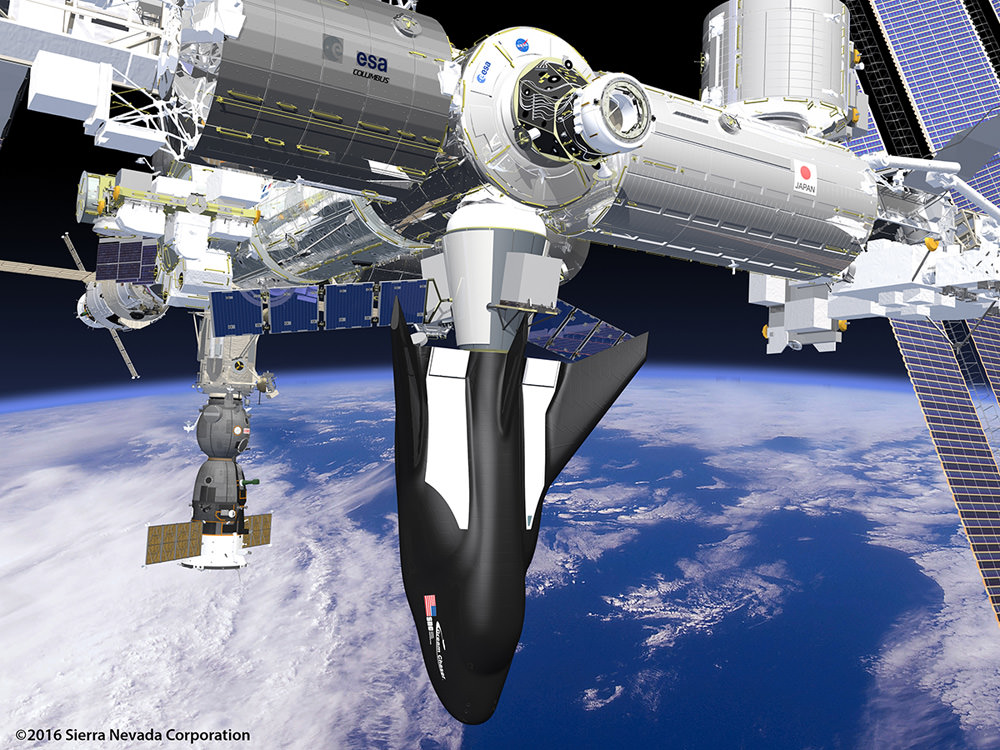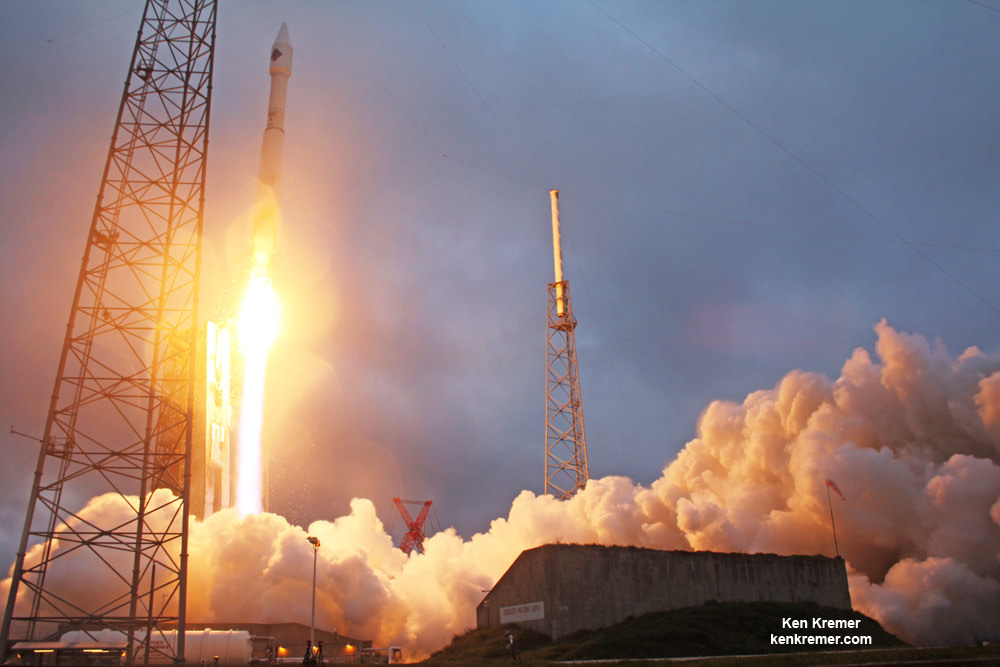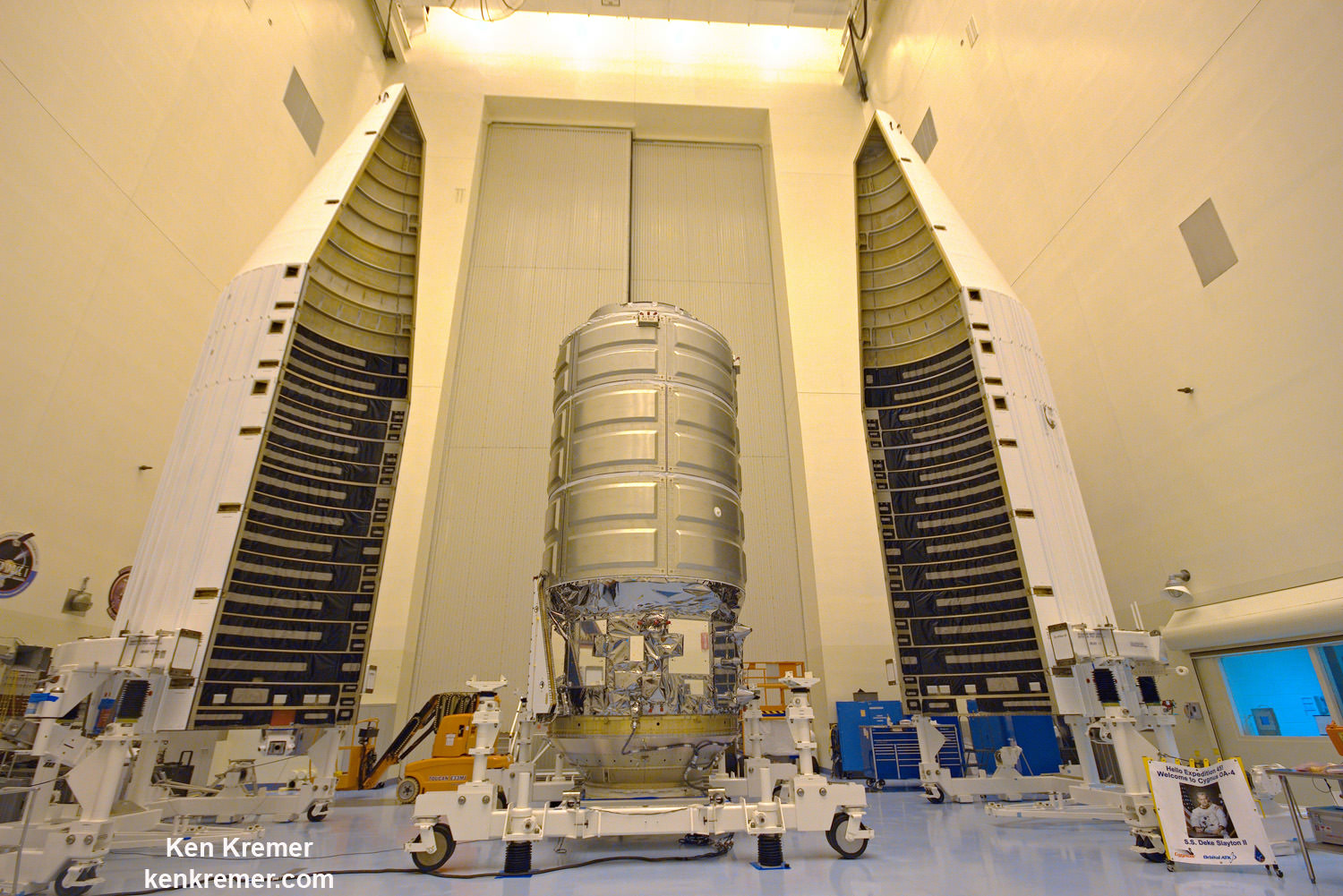
A shuttle will soar again from American soil before this decade is out, following NASA’s announcement today (Jan 14) that an unmanned version of the Dream Chaser spaceplane was among the trio of US awardees winning commercial contracts to ship essential cargo to the International Space Station (ISS) starting in 2019.
In addition to the Dream Chaser mini-shuttle built by Sierra Nevada Corporation of Sparks, Nevada, NASA decided to retain both of the current ISS commercial cargo vehicle providers, namely the Cygnus from Orbital ATK of Dulles, Virginia and the cargo Dragon from SpaceX of Hawthorne, California.
Thus with today’s announcement, NASA decided to plus up the number of ISS commercial cargo providers from two to three for the critical task of ensuring the regular delivery of critical science, crew supplies, provisions, spare parts and assorted gear to the multinational crews living and working aboard the massive orbiting outpost.
By adding a new third provider, NASA simultaneously gains the benefit of additional capability and flexibility and also spreads out the risk.
Unlike the Cygnus which burns up on reentry and Dragon which lands via parachutes, the reusable Dream Chaser is capable of low-g reentry and runway landings. This is very beneficial for sensitive scientific experiments and allows much quicker access by researchers to time critical cargo. Dream Chaser will be capable of delivering 5,500 kg of pressurized and unpressurized cargo to the ISS.

Each of the three aerospace firms “is guaranteed a minimum of six cargo resupply missions through 2024,” said Sam Scimemi, ISS Division director at NASA Headquarters in Washington, in announcing the three awards at today’s media briefing.
Beyond the minimum of six flights, NASA has the option to award additions missions.
These new awards secure continuing ISS resupply through its currently approved operational period to 2024 by all the partners except ESA – which is still evaluating its options.

The award to Sierra Nevada amounts to a huge reversal of fortune for the Dream Chaser spaceplane – which lost out in its prior bid in 2014 to win a commercial crew program (CCP) contract to fly a manned version of Dream Chaser from NASA.
The Boeing Starliner CST-100 and SpaceX crew Dragon ultimately were awarded the CCP contracts in September 2014 to fly astronauts to the ISS. The first crewed launches are expected in 2017.
Both SpaceX and Orbital ATK suffered catastrophic launch failures during ISS resupply missions, in June 2015 and October 2014 respectively, from which both firms are still in the process of fully recovering from.
The new contracts were awarded as part of NASA’s long awaited second round of Commercial Resupply Services (CRS-2) contracts to obtain regular and reliable cargo delivery services to the space station from 2019 through 2024. Other covered services include the disposal of unneeded cargo, and the return of research samples and other cargo from the station back to NASA and researchers.
NASA says the total value of all the cargo awards from 2016 to 2024 is worth $14 Billion. The agency “will order missions, as needed, and the total prices paid under the contract will depend on which mission types are ordered.”

The first round of CRS awards to SpaceX and Orbital ATK was made in late 2008. The goal was to replace the critical cargo delivery services formerly provided by NASA’s trio of manned space shuttle orbiters, that were subsequently retired in 2011. Shuttle flights ended before either of the private cargo freighters were ready to liftoff.
Both SpaceX and Orbital ATK have been flying their commercial Dragon and Cygnus resupply ships to the ISS. The first cargo flight by occurred in 2012 under the initial CRS contract.
“So far over 35,000 pounds of cargo has been delivered to the ISS,” said Scimemi.
“Commercial resupply a new way of doing business. We are learning. But it has not been easy. Both original providers had launch failures.”
The new contracts also include funding ISS integration, flight support equipment, special tasks and studies, and NASA requirement changes.
“Few would have imagined back in 2010 when President Barack Obama pledged that NASA would work ‘with a growing array of private companies competing to make getting to space easier and more affordable,’ that less than six years later we’d be able to say commercial carriers have transported 35,000 pounds of space cargo (and counting!) to the International Space Station — or that we’d be so firmly on track to return launches of American astronauts to the ISS from American soil on American commercial carriers. But that is exactly what is happening,” said NASA Administrator Charles Bolden, in a statement.
“Today’s announcement is a big deal that will move the president’s vision further into the future.”
The new awards start today as NASA negotiates the specifics of which company will fly what cargo and when for example.
“The second generation of commercial cargo services to low-Earth orbit begins today,” said Kirk Shireman, ISS Program manager at NASA’s Johnson Space Center in Houston.
“By engaging American companies for cargo transportation, we can focus our attention on using this one-of-a-kind laboratory in the sky to continue advancing scientific knowledge for the benefit of all humanity.”
An increased up mass cargo capability is essential for fully utilizing the ISS research capabilities as well as providing additional science experiments and provisions to carry out NASA’s plan to increase the crew size to seven.
“These resupply flights will be conducted in parallel with our Commercial Crew Program providers’ flights that enable addition of a seventh astronaut to the International Space Station. This will double the amount of crew time to conduct research,” said Julie Robinson, chief scientist for the ISS Program.
“These missions will be vital for delivering the experiments and investigations that will enable NASA and our partners to continue this important research.”
The next currently scheduled American ISS commercial cargo flights are slated to take place in the next two months or so.
“The next Orbital ATK mission named OA-6 will launch on March 10 from Cape Canaveral,” Scimemi told Universe Today.
“SpaceX will announce the date of their next mission named CRS-8 soon.”

Other current cargo providers to the ISS include the Russian Progress and Japanese HTV vessels.
Stay tuned here for Ken’s continuing Earth and Planetary science and human spaceflight news.

Pleased about this as the Dreamchaser concept is a good one. I notice that SNC has a part (literally) in just about everything space, especially the Orbcomm satellites launched by SpaceX, let’s hope a success in cargo launches puts them back in the crewed stakes.
“Unlike the Cygnus and Dragon which land via parachutes”
Cygnus burns up during reentry.
The Dream Chaser’s back! SuuWEET! Congress has more than restored funding for science, are we to assume this is part of that newly appropriated funding? NICE! Tell me I’m not dreaming. This news MADE MY DAY because it’s mostly MADE IN THE USA!
Oh yeah.. what better way to prep for a manned version?
The cargo version of the DC has folding wings. Will the manned version have that feature too?
Any idea on which booster will be mated to the Dream Chaser ?
Am I allowed to dream of ever seeing it on top of a Falcon 9 Heavy ?
This would make it close to the original concept of the Space Shuttle.
Falcon 9 for Dragon, Antares for Cygnus, and Atlas V for DreamChaser (inside a payload fairing) .
Any idea on which booster will be mated to the Dream Chaser?
Am I allowed to dream of ever seeing it on top of a Falcon 9 Heavy?
This would make it close to the original concept of the Space Shuttle.
Nice thought, the folding wings make it possible and its cargo capacity of 5500kg compares well with the 6000kg of Dragon too. If Atlas can’t successfully replace the RD180 then I can see a cargo launch on a standard Dragon happening soon. Spacex and SNC already work together so if SNC do manage to get a crew contract you never know, but a Falcon heavy is unlikely as Dreamchaser is not designed for anything beyond LEO.
“A shuttle will soar again from American soil before this decade is out”
Poor little X-37B…. gets no respect.